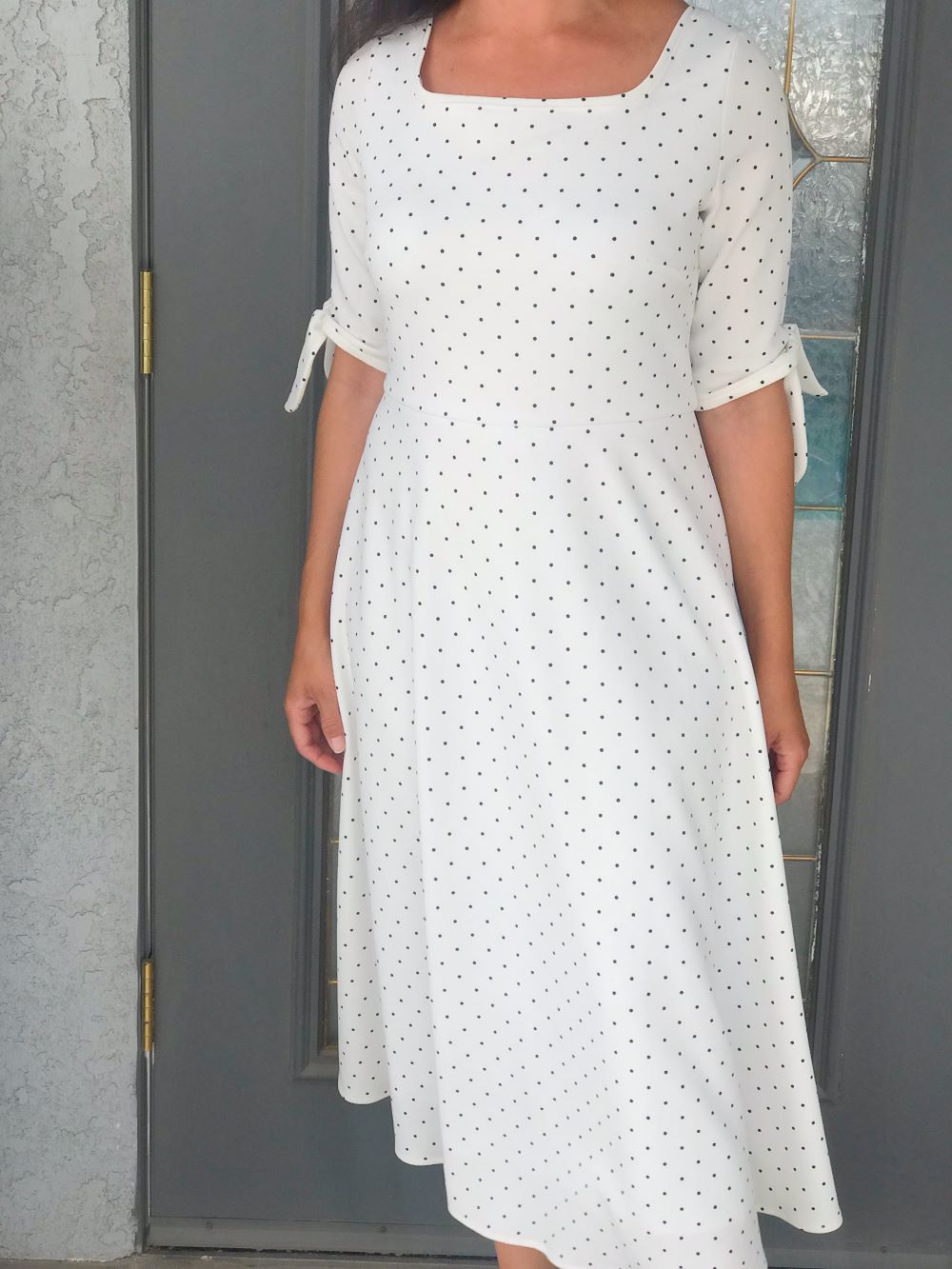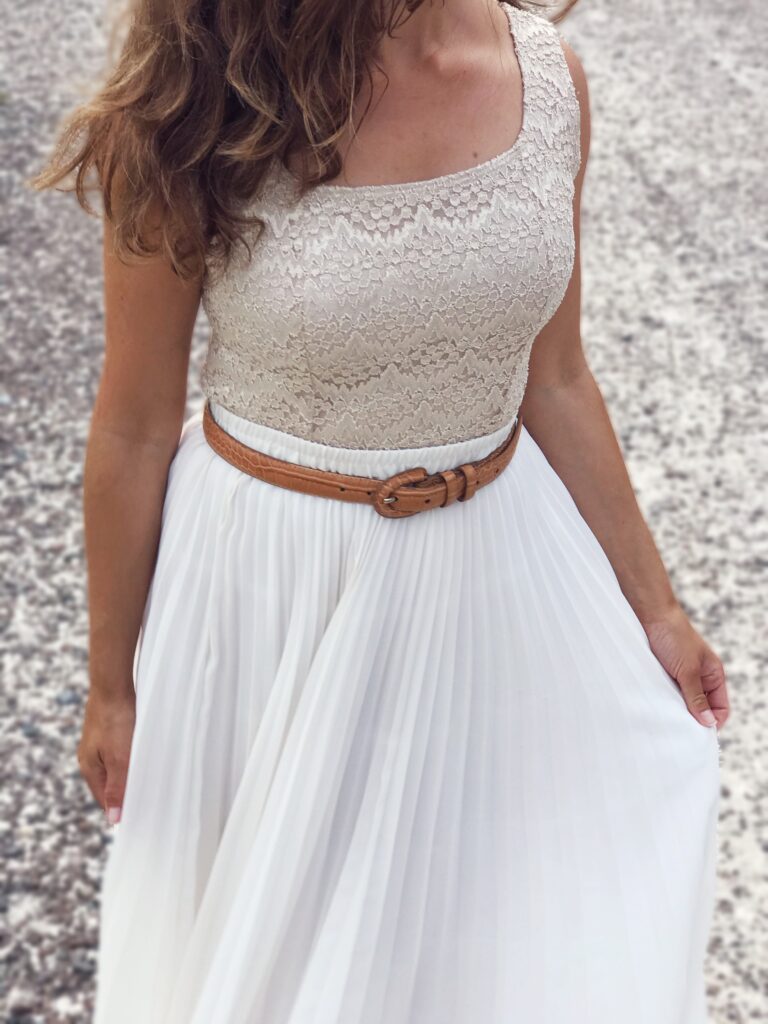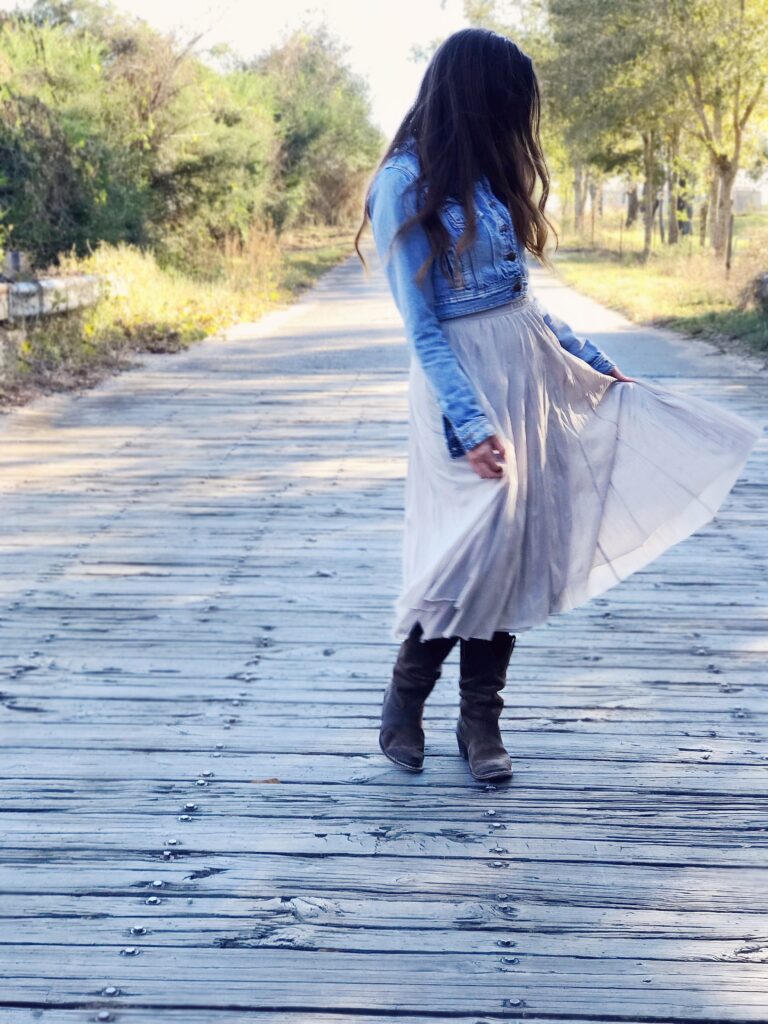
Ladies,
A polka dot dress fits seamlessly into any season as it is neither a hot weather nor a cold weather style. This dress not only works at any time. but it helped give me that lift out of heavier winter styles into spring without looking too springy too soon.
Aside from my fabric choice, the key to picking a sewing pattern that you will make again and again is all about the shape of the dress. This dress has many features that make it a favorite. The square neckline, the elbow length sleeve option, the waistline at my true waist, and a tea length slim yet flowy skirt. What’s more is this pattern offers a sleeveless option, a cap sleeve, as well as the tie detail on the elbow length.

This review is for View A with the tie sleeves from View D.

Simplicity 8874 View A
Size Used: 12
Size notes: Size 12 fit in the armholes, sleeves and neckline. But was surprisingly too small in width of the shoulders. It was also too small for me in the bodice & skirt using the standard 5/8′ seam allowance. By using 3/8″ seam allowance in the bodice and skirt it fit exact. This ran a bit smaller than a typical sewing pattern size 12 in my opinion, probably somewhat snugger due to it being a knit fabric pattern meant for stretch knit fabric. My fabric was a stable knit which did influenced things to be more fitted rather than a stretchier/silk knit that would need the smaller fit.
Seam allowance changes: Changed seam allowance to 3/8″ for the following: Back seam of skirt, side seams of skirt, side seams of bodice.
Seam allowance not changed: Kept 5/8″ seam allowance for the following: Shoulders, Armholes, sleeves, bodice back seam, skirt to bodice seam.

Petite & Modesty Fit Adjustments
Petite adjustments have to do with the vertical measurements of a garment. For instance, since sewing patterns are drafted for a person of a height of 5’4″ or taller, the garment will be too long in the area between the shoulders and bust for a petite person. The length of area from the base of my neck to my bust is shorter than a taller person, meaning I have to raise necklines by several inches to make them sit where it would sit on a taller person. But I also prefer higher necklines, so it is often times not just a petite adjustment, I am making a modesty adjustment for where I want a neckline to sit higher. But there are other petite adjustments that I have to do for fit, not just modesty.
Front & back neckline was too low. Raised neckline 2.5″, raised back neckline 2.5″, reduced neckband 2.75″.
The upper back was 2″ too loose around the upper back/neckline. Reduced upper back/neckline width (not height) 2″.
The bust dart was way too long, and the point sat exactly at the bust apex. However on this printed fabric that was disguised greatly. This dress did not receive the reduction, but I altered the pattern piece and reduced bust dart by 2.5″ to sit on side of bust not on the apex for subsequent garments.
Skirt too long. Shortened skirt 4″ for tea length (just above the ankle).
The shoulder width was too narrow with the seam being too high on the shoulder. It took some time for the fabric to relax and hang better around shoulder. Shoulder seam needs to be graded to a size 14 for a stable knit but will work in a size 12 for a stretchier knit.
What worked without fit adjustment: No petite waist adjustment needed. The waist sat high for a non-petite pattern. Warning for anyone who is not petite. This waistline does sit high, and it seems purposeful to this dress design.

Design Adjustments
Unlike fit adjustments which have to do with how a garment fits correctly, design adjustments are not necessary but are changes to the style of the garment.
I cut the skirt front pattern piece on the fold to eliminate the front seam. This made it a slightly bias-cut skirt. I did not subtract the seam allowance from the skirt front when I cut it on the fold. This gave the belly more space and it looked smooth with no tucks or ripples when sewn to the bodice. It fit me better for not being any tighter.
I aligned the back pattern piece directly below the front pattern piece in order to get the grainlines on the exact same angle. I cut the skirt back pattern piece 1″ in from the fold in order to cut 2. I would not eliminate the front skirt seam in every creation, but for certain fabric/style it looks better. The bias-cut skirts work beautifully.

I made a longer version of the long sleeve pattern piece. Lengthened long sleeve 3.75″ and lowered the dots for the tie hole accordingly.

How many times sewn this pattern: Two times.
Describe each creation: The first was View A in a Liverpool knit in an ivory background with mini black polka dot print. This dress has the long sleeve (using my even longer version of 3.75″ added length) with the tie detail. I fully lined the polka dot dress with white ITY fabric. The liverpool knit fabric has a subtle texture and is a more stable knit than other types lending it a more structured appearance, a heavier drape and is a slightly “dressier” knit compared to say, jersey knit.
The second make was View C in a Liverpool like knit (solid yellow) and the shoulder issue and bust dart issue were such severe and obvious problems in a solid color that I had to scrap the entire bodice to widen the shoulders & reduce the bust dart and remake the yellow bodice with the fit adjustments. I fully lined the yellow dress with a white light weight polyester interlock lining fabric.

What I love about this dress pattern
The rounded edged square neckline is a beautiful shape and very flattering. I love the sleeve options and especially the style detail of the ties on the sleeves. This silhouette of dress is one of my go-to for any dress I make. When fitted correctly, this shape does not add bulk to my belly or hips. The shape is neither too slim nor too poofy. It has a good amount of fabric to give it swish but retains a sleek look.

Pattern Instruction likes or dislikes
Every step was clear and easy to understand. Instructions produced exact results when followed. I did the sleeves exactly as described and they were the best sleeves I have ever done for both the cap sleeves and the tie sleeves.
What I dislike about this pattern: Nothing disliked.
Difficulty Level: This is not a difficult pattern, but any fit adjustments are what take knowledge to do correctly. This is a good pattern for a beginner to learn how to do those kinds of adjustments, if needed at all for the individual.
Most Challenging Part: The neckband needs to be sewn extremely carefully on the curves so that it maintains alignment with the bodice edge. Every stitch needs to be in a straight line along the guide. Any slight veer off the guide or any fabric shifting out of alignment along edge will show in the neckband looking wider or narrower in places. Pin in excess and go slow. I redid the neckband 4 or 5 times before I determined which neckband reduction length worked with my neckline reduction and until the band was sewn even all around.

Would I sew it again: Yes, and I would like to make many more now that my fit adjustments have been made. This dress comes together quickly.
Happy sewing!
WHATEVERLOVELY.COM
CHRISTIAN LIVING – FASHION – HOME





Leave a Reply